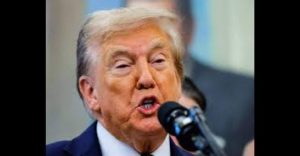
In a significant update to U.S. foreign drug policy, former U.S. President Donald Trump named Afghanistan, India, China, and Pakistan among 23 countries identified as major drug transit or illicit drug producing countries. This annual determination, submitted to the U.S. Congress, forms part of Washington’s global strategy to combat drug trafficking and limit the flow of narcotics into the United States.
This development brings renewed attention to how international drug trade routes operate and the role certain countries—willingly or not—play in facilitating the supply of narcotics or their precursor chemicals.
Why These Countries Are Named
Under U.S. law, the president must annually identify nations that are either significant producers of illicit drugs or serve as key transit routes for drug trafficking. Inclusion on this list doesn’t necessarily mean a country is failing to combat narcotics or that it is complicit in drug smuggling. Rather, it reflects a combination of factors: geographic location, access to chemicals, border vulnerabilities, and existing trafficking networks.
President Trump emphasized that Afghanistan, China, India, and Pakistan were included due to their roles in either the production of drugs or as critical passageways for narcotics. He stressed that the United States needs global cooperation to combat the surge in synthetic opioids and other dangerous substances that are contributing to a public health crisis back home.
Country-by-Country Overview
- Afghanistan: Despite the Taliban’s public stance on banning opium cultivation, U.S. assessments suggest that drug production in Afghanistan is far from over. The report indicates that methamphetamine production has increased and that the Taliban may still profit from narcotics networks, undermining international counter-narcotics efforts.
- China: China has long been flagged as a key origin for precursor chemicals used in the manufacture of synthetic opioids like fentanyl. Trump’s administration again highlighted China’s role, stating that Beijing must crack down on the export of these chemicals and prosecute those responsible for their diversion into illicit use.
- India: India’s inclusion is largely tied to its position as a major producer of pharmaceutical chemicals. While most of this production is legal, a lack of stringent controls on chemical diversion can create vulnerabilities. The U.S. is particularly concerned about precursor chemicals being redirected toward illegal synthetic drug manufacturing.
- Pakistan: Pakistan has been identified as both a transit and production point, particularly for heroin originating in Afghanistan. U.S. officials also cite a need for greater regulatory control in Pakistan’s border areas, where trafficking is difficult to monitor due to terrain and governance gaps.
Not All Countries Are Treated the Same
It’s crucial to distinguish between countries named on the list and those declared to have “failed demonstrably” in their counter-drug efforts. Among the 23 countries listed, only five—Afghanistan, Bolivia, Burma (Myanmar), Colombia, and Venezuela—received that harsher designation.
India, China, and Pakistan, while highlighted for their involvement in global drug routes or chemical exports, were not accused of non-compliance. This suggests that while the U.S. sees these countries as part of the global drug problem, it also acknowledges ongoing cooperation or the presence of law enforcement efforts.
Implications of the Designation
- Diplomatic Pressure: Being placed on this list can serve as a diplomatic signal, pushing nations to intensify efforts against narcotics and cooperate more closely with the U.S. on information-sharing, law enforcement, and regulatory oversight.
- Impact on Foreign Aid: In cases where a country is found to have failed demonstrably, U.S. foreign assistance—particularly in the areas of security, justice, and development—may be restricted or made conditional on improvements. Though India, China, and Pakistan have not been labeled as failing, future assessments could influence aid strategies.
- Trade and Regulation Concerns: For countries with significant chemical and pharmaceutical industries, such as India and China, this designation brings attention to the need for stricter regulation of chemical exports. Diversion of legally produced chemicals into illegal drug manufacturing remains a major international concern.
- Internal Political Ramifications: Domestic opposition parties and civil society in countries like India or Pakistan could use this international scrutiny to push for policy reforms, enhanced law enforcement capabilities, and tighter border security.
Reactions from Affected Countries
Although official responses from the named countries have been limited so far, similar past designations have drawn mixed reactions:
- India has typically responded by highlighting its comprehensive legal framework to control narcotics and its long-standing cooperation with the U.S. Drug Enforcement Administration (DEA). New Delhi may argue that inclusion in the list reflects its geographic position rather than systemic failure.
- China, in the past, has pushed back strongly against such designations, asserting that it is unfairly blamed and that it has taken serious steps to regulate the export of fentanyl precursors.
- Pakistan often points to its domestic anti-narcotics operations and the challenges it faces in policing rugged border regions.
- Afghanistan, under the Taliban, may not offer a formal diplomatic response, but international observers continue to report widespread trafficking activities under the current regime.
The U.S. Context: Why Now?
This annual designation is partly driven by domestic U.S. concerns. The opioid crisis in America remains a serious health emergency, with fentanyl and its analogues responsible for tens of thousands of overdose deaths annually. Identifying foreign countries involved in production or transit is part of the U.S. strategy to stem the flow of drugs at their origin or along supply chains.
Former President Trump has consistently emphasized the role of foreign actors in America’s drug crisis. By calling out these countries, he aims to put international pressure on producers and exporters, and to demand more proactive global enforcement.
Moving Forward
Going forward, the countries named—especially those with large chemical and pharmaceutical industries—are likely to face increased scrutiny. The U.S. may push for enhanced regulatory standards, better tracking of chemical exports, and stronger border control mechanisms.
However, cooperation, not confrontation, will likely be the key to making progress. Multilateral engagement through forums like the UN Office on Drugs and Crime (UNODC) and bilateral agreements may offer better outcomes than simple pressure tactics.
Conclusion
While India, China, Pakistan, and Afghanistan have all been named in the latest U.S. list of major drug-producing or transit countries, the implications of their inclusion vary. For India and China, the focus is likely to remain on regulating precursor chemicals. For Pakistan and Afghanistan, controlling trafficking routes and curbing production will be central. The U.S. decision sends a clear message that drug control is no longer a purely domestic issue—it’s a global security priority with wide-reaching diplomatic consequences.








